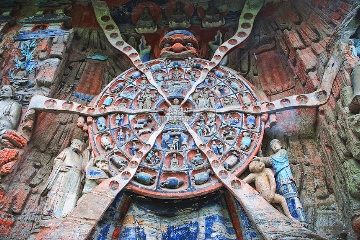The Dazu Rock Carvings, located in Dazu District, Chongqing, are a remarkable collection of stone carvings dating back to the Tang Dynasty. Comprising 141 cliffside sculpture sites, these carvings are primarily Buddhist but also include Daoist and Confucian influences, reflecting the harmonious coexistence of these philosophies during their creation. The carvings began during the early Tang Dynasty and reached their peak in the Song Dynasty, with additional work during the Ming and Qing dynasties. They are renowned for their large scale, intricate details, and excellent preservation, making them a significant example of late-period Chinese cave art.

The Beishan Rock Carvings, historically known as Longgang Mountain, were initiated by Wei Junjing in 892 AD during the Tang Dynasty. Over 250 years, from the late Tang Dynasty through the Five Dynasties and into the Southern Song Dynasty, the site was continuously developed. The Beishan carvings are renowned for their intricate detailing and elegant aesthetic, providing a vivid display of the evolution of Chinese folk Buddhist beliefs and stone carving techniques.
The Baodingshan Rock Carvings are the largest cluster within the Dazu Rock Carvings. The Dafowan site features a continuous expanse of carvings that span approximately 500 meters in length. The carvings are predominantly esoteric Buddhist in nature and are considered exemplary works of Song dynasty stone carvings. Notable carvings include the Thousand-Armed Guanyin and scenes from the life of Shakyamuni Buddha.
The Shuchengyan Rock Carvings are a significant example of Daoist rock carvings, created between 1143-1153 during the Southern Song Dynasty. These carvings primarily depict various Daoist deities and provide invaluable insights into the development and transformation of Daoist traditions.
The Miaogaoshan Rock Carvings, dating back to the Southern Song Dynasty, are an impressive display of primarily Buddhist sculptures. Notably, one niche features a triad representation of Confucius, Laozi, and Buddha, illustrating the convergence of Confucianism, Daoism, and Buddhism.
The Nanshan Rock Carvings, carved during the Southern Song Dynasty, are predominantly Taoist in nature. They are the most complete group of Taoist statues from this period in China, showcasing a sequence of gods from the Taoist "Three Qings and Four Royals" to the 360 Tianzun.
The Dazu Rock Carvings were designated a UNESCO World Heritage Site in 1999, recognized for their cultural and artistic significance. They stand as a testament to the artistic prowess and cultural significance of humanity’s past, offering visitors a profound journey through China’s rich artistic and spiritual heritage.




































